Poor Girl Eats Unprocessed (Sweet Potato, Mango, and Edamame Salad)
Oct 23, 2011, Updated Oct 03, 2017
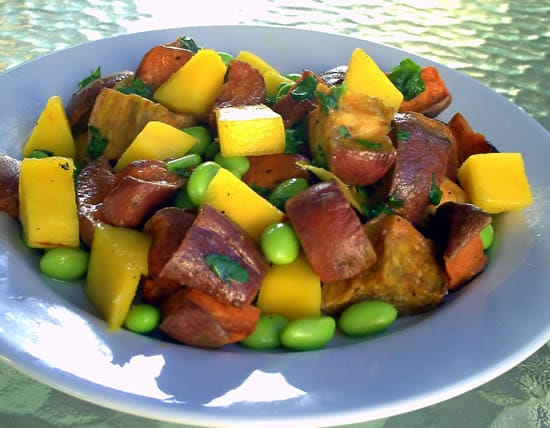
One of the most common questions I’m asked is, “How do you do that? How do you eat such great meals when you’re so admittedly broke?”
It’s an excellent question, and the one that actually prompted me to start my blog. Over the years I’ve been able to make my meals much tastier, healthier and affordable by being more conscious of the things I shop for and how I make use of them.
But with food prices skyrocketing around the world – healthy foods in particular – a lot of folks are convinced that it’s too expensive to eat things like fresh fruits & veggies, whole grains, and other good-for-you foods. Unfortunately, this is why so many people fall into the processed food trap, with big food companies reaping all the financial benefits.
The good news is that it doesn’t have to be so difficult to eat good, unprocessed food if you’re on an extremely tight budget. Sure, it might not always be possible to buy things that are certified organic, but organic doesn’t have to be the only definition of “unprocessed.” If you’re in dire financial straits like I am, just being able to enjoy fresh produce and non-junk food items is a welcome change from all the cheap, processed junk out there.
So how do I eat so well and (for the most part) unprocessed on a regular basis? How can you make the most of your unprocessed food dollar during the rest of this challenge and beyond? Here are three of my favorite ways to do so…
1. Visit Your Local Farmers Market
I try to buy most of my produce at the farmers market for a variety of reasons, the two biggest being price and quality. The produce is fresh, in season and local, which supports struggling local economies. Since the overhead costs of transportation and other things that jack up produce prices at grocery stores (hello, fluoridated water drenching my spinach!), the prices at the farmers market can be considerably less.
Another reason I prefer to get my produce from the farmers market is that many of these smaller, local farms don’t use pesticides like the big guys do. So, even if there’s not a “certified organic” sign hanging from their stand, there’s a good chance that you’re still getting pesticide-free food. (Remember, those certifications cost a lot of money, which some of these smaller farmers cannot afford!)
How can you be sure you’re getting the best produce from your farmers market? Talk to your farmer! They’re more than happy to answer questions about their food – in fact, they’re proud of it! Ask how they grow the produce they sell, if they use pesticides, and how their fruits & veggies can be used. Chances are you’ll walk out with some great tips – and some lovely, affordably priced food.
2. Buy Whole Ingredients
This one may seem obvious, especially now that we’re in the middle of the challenge and so many wonderful guest posters have shared delicious unprocessed recipes. But I find it’s a helpful practice year round, especially in this difficult economic climate.
So what exactly counts as a “whole ingredient?” Don’t worry – I’m not saying you need to mill your own flour or grind your own corn (though, if you have the knowledge, time and resources, go for it!). What I mean is that divorcing yourself from convenience foods – even the good kind like pre-cut veggies or those handy bagged frozen dinners for two – is much better for you (and your wallet).
Consider those oh-so-convenient bagged frozen dinners. With restaurant-style dish titles such as Chicken Fettuccine Alfredo or Shrimp Scampi, spending $8 on a bag of dinner for two people seems like a great idea at first. But once that’s been consumed, all you really have to show for it is a nice one-time meal and an empty bag.
Purchasing the whole ingredients needed for, say, a pasta alfredo with vegetables, will cost you about the same amount and last much longer. How? If you’re cooking for two, you definitely won’t need the entire bag of pasta; the same goes for the vegetables and the ingredients for the sauce. When all is said and done, you’ll not only have a delicious meal for two, you will also have about half of all those ingredients left over to use in different recipes of your choice. All for the same amount you would have paid for one “convenient” meal. And you’ll know exactly what went into your meal.
3. Stock Up On “Bare Bones” Staples
I go through some particularly lean times every month (usually around rent time), so I try to make sure I’m well-stocked on certain staples that I know are filling, nutritious, and will yield a large amount of cooked product that I can stretch out over several meals. I call these my “Bare Bones” staples, because sometimes that’s all there is left to eat until the following payday.
Rather than subsist on things like Chef Boyardee or endless foam cups of cheap ramen – things that have little to no nutritious value – I try to keep a nice variety of whole grains & legumes in my pantry. Since they’re non-perishable, I can buy them during the non-scary pay period and have them on hand for a variety of dishes.
Some of my favorites to have on hand:
- Brown Rice
- Quinoa
- Whole Wheat or Brown Rice Pasta
- Dried beans (black, navy, cannellini, lentils, etc.)
- Wheat berries
- Bulgur
- Orzo
- Couscous (both traditional and Israeli/pearl)
While most of these can be found at relatively affordable prices, I try to buy most of my bare bones staples in bulk. Many large grocery chains now have bulk bins with nutritious options like whole grains, pastas, rice, etc., making it possible to save quite a bit on some of these items. With the aid of leftovers and a huge helping of kitchen creativity, I’ve been able to turn some of those “bare bones” staples into some of my favorite meals. Because they yield so much when cooked, I can stretch those meals to last over a few days, keeping my costs low and my tummy full.
I hope you’ve found these tips helpful and that they’ll carry you through the rest of your Unprocessed journey. Good luck on the rest of the challenge!
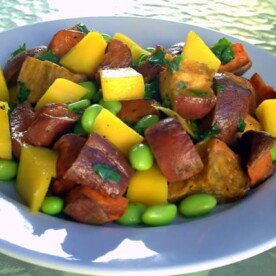
Sweet Potato, Mango, and Edamame Salad
Ingredients
- 4 small Sweet Potatoes
- 1 large Mango
- 1/2 cup shelled Edamame
- 2 Tbs. plus 1 Tbs. Olive Oil
- Sea Salt and freshly ground Pepper
- 1 Lemon, juiced
- 2 Tbs. Honey
- 1 Tbs. Rice Vinegar
- Small handful of finely chopped Cilantro
Instructions
- Preheat the oven at 425° F.
- Rinse & scrub the sweet potatoes well and pat dry. Cut into 1 1/2” cubes and place in a bowl. Add the 2 Tbs. olive oil and a generous dash of salt & pepper and toss until well-coated. Spread the sweet potatoes onto a foil-lined cookie sheet and roast for about 15 minutes or until tender.
- While the sweet potatoes are roasting, prepare the dressing by combining the remaining tablespoon of olive oil, lemon juice, honey, rice vinegar, and cilantro, and whisk together well. Set aside.
- Peel & cut the mango into 1” cubes, and if you’re using frozen, whole edamame, thaw & shell it so you have the individual beans at your disposal.
- When the potatoes are done roasting, allow them to cool for a few minutes. Combine the potatoes, mango, and edamame in a large bowl. Drizzle the dressing on top & toss lightly.
- Serve on a bed of greens or on its own, and enjoy!
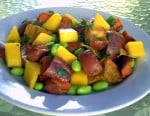

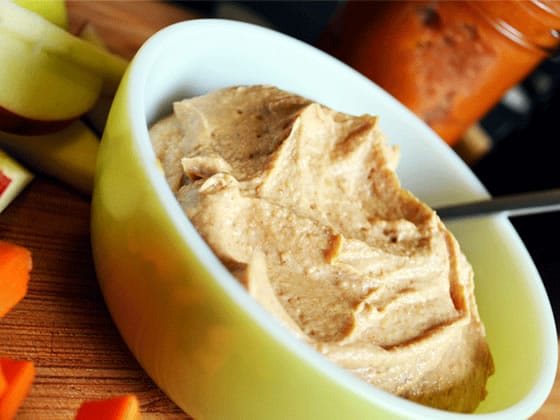

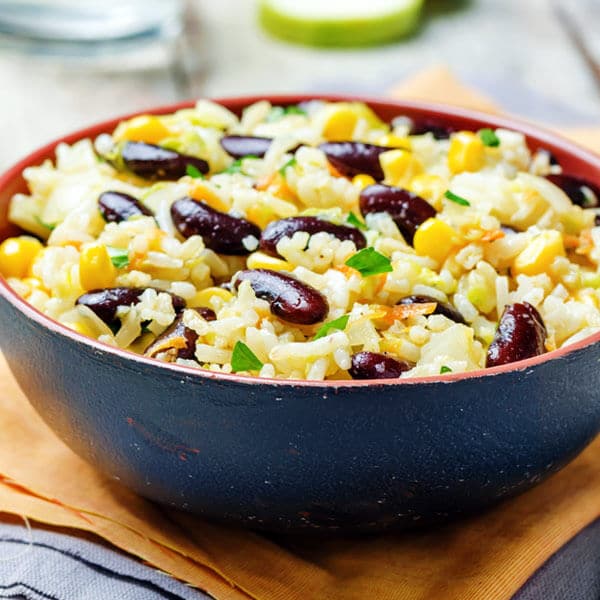
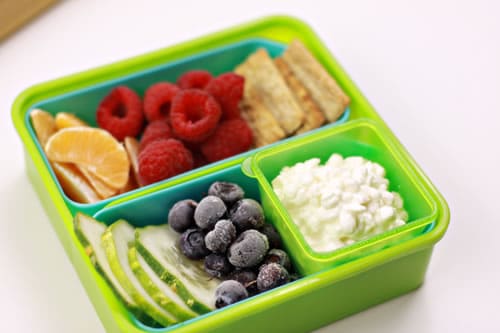















Mmmm, this looks good. I definitely will be giving this a try. Thanks for the recipe.
YAY! So thankful I found this today. I happen to have everything in the house and am on a 10 day cleanse. This is going to be perfect and easy to make for dinner. I will reshare it on my blog and let everyone know it came from you!! Thank you.
Being able to can has enabled me to take advantage of the super low prices of seasonal fruits and vegetables to last the whole year round. I spent $6 on 30 ears of corn when it was in season and have 7 quarts of fresh corn kernels in my pantry ready at a minutes notice. My husband and I also take advantage of whole chickens when they go on sale for $.79 or so and buy as many as we can at the time to keep in the freezer. Not only do they make a couple meals in themselves, but when picked clean, the bones are thrown in the freezer with vegetable scraps to make stock out of in the future. Just yesterday we canned 7 quarts of fresh chicken stock and froze 2 more quarts. That’s basically 2 meals plus stock from one $4 chicken. Not too shabby!
Thanks for all the kind words, everyone! I’m glad you enjoyed the tips & recipe. And I completely agree with you, Danielle! A lot of folks who are new to my blog sometimes feel a little overwhelmed by the idea of being able to eat real food despite their financial hardships. I try to remind folks that there’s no need to jump right into going completely unprocessed/organic/etc. if they’re not able to afford so just yet. Heck, I’D love to be able to buy certified organic food everyday! I’d be able to make my food last quite awhile; unfortunately, I don’t always have the disposable income to pay for those products in the first place (one or two things, maybe). In this economy, a lot of others are in the same boat, so I try to encourage them to take baby steps. As their financial situation improves, they can “graduate”… Read more »
That is very helpful information. Thanks for taking the time to type all that out. I think there are a lot of people who want to eat healthier but just don’t know where to start, and they get scared off by the prices of organic food and the lack of familiarity of healthier ingredients. But if people start with a few basic things, and learn a few simple recipes, they can build their confidence.
I enjoyed your article. It was very affirming of the way I shop and cook. I’ve enjoyed using grains I’d never heard of (Farrow) and using a variety of herbs or seasonings to make them taste so very satisfying.
Great advice and great recipe!
I’ve been trying to eat out of my freezer, I love to freeze leftovers but forget that they’re in there! So I’m learning to keep a list of my frozen items so they won’t go to waste!
Farmer’s markets can be great. We’re just getting our first frost here, so my favorite tomato vendor had way to many, and let me have all I could fit into the pannier on my bike for $6. Now I just have to can them!!! and now that’s all the tomatoes I’ll need until next summer…
Flour is another ingredient I stock up on whenever it goes on sale. Flour+my sourdough starter+tap water+pinch of salt= bread.
Great Stuff! Thanks for sharing.
Those bare bones staples are so important!! It’s amazing how often those become useful. This past week while my kids were sick and my husband was out of town, our staples saved me from having to take two sick kids to the grocery store. This salad looks incredible, and something my family will love. (My girls will inhale anything with edamame in it.)